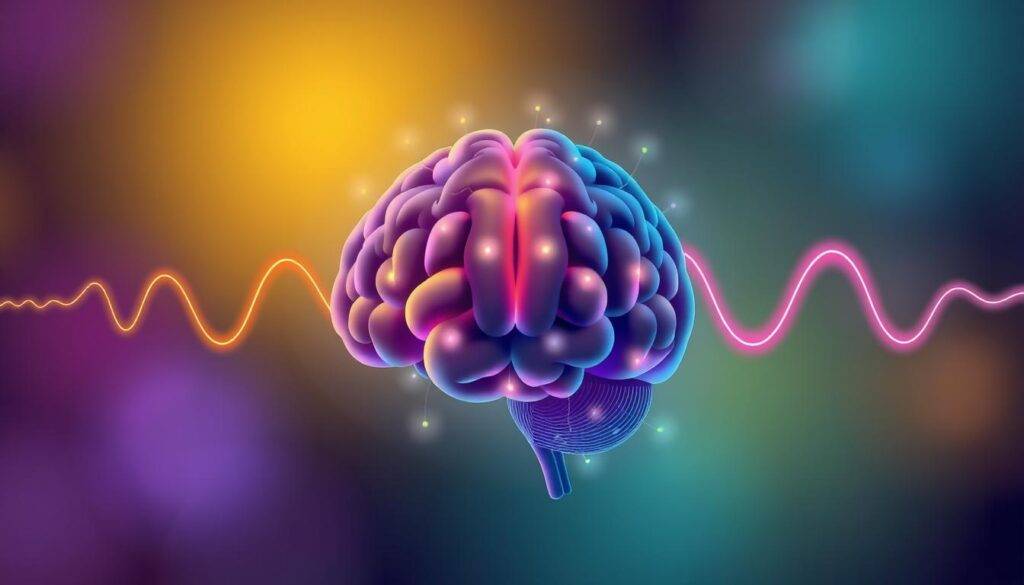“The brain is a wonderful organ; it starts working the moment you get up in the morning and does not stop until you get into the office.” – Robert Frost, American Poet
The human mind is filled with a symphony of neural oscillations. These electrical impulses shape our consciousness and well-being. Alpha and theta brain waves, with frequencies of 8 to 12 Hz and 4 to 8 Hz, unlock our mind’s potential.
Key Takeaways
- Alpha and Theta brain waves are associated with relaxation, creativity, and enhanced mental performance.
- Understanding the science behind neural oscillations and the different brain wave types is crucial for optimizing cognitive abilities.
- Meditation and advanced techniques like binaural beats can help you actively cultivate and harness the power of alpha and theta states.
- Practical applications of brain wave training include improved focus, problem-solving, and overall well-being.
- Overcoming common challenges in brain wave training can lead to long-lasting benefits for your personal and professional life.
Understanding Brain Wave Frequencies and States
The human brain is amazing, always sending out electrical signals called brain waves or neural oscillations. These signals are caught by electroencephalography (EEG), a tool that lets us see and study the brain’s activity. By knowing the different brain wave frequencies and what they mean, we can learn a lot about our minds.
The Science Behind Neural Oscillations
Neural oscillations happen when groups of brain cells work together in sync. They show up at different frequencies, each linked to a specific mental state or task. Thanks to brain-measuring tech like MRI and functional MRI, we now know more about how the brain works.
How EEG Measures Brain Activity
EEG is a common method for checking the brain’s electrical activity. It’s good at showing when brain activity happens, but not always where it happens. By looking at brain wave patterns from EEG, scientists can understand how the brain works and how different parts talk to each other.
The Five Major Brain Wave Types
- Delta waves (0.1-3 Hz) are linked to deep sleep, healing, and regeneration.
- Theta waves (4-7 Hz) are connected to deep relaxation, creativity, and intuition.
- Alpha waves (8-12 Hz) are associated with a state of relaxed alertness and mindfulness.
- Beta waves (16-30 Hz) are connected to active thinking, problem-solving, and focus.
- Gamma waves (30-100 Hz) are associated with higher-level cognitive processing, such as information integration and peak performance.
Each brain wave type is important for different mental and physical processes. Knowing about these states helps us understand how to use our minds to the fullest.

Alpha and Theta Brain Wave States: Essential Characteristics
Explore the fascinating world of alpha and theta brain waves. These neural oscillations are key to our mental states and how we think. Alpha waves, with a frequency of 8-12 Hz, help us stay alert yet relaxed. They also connect our conscious and subconscious minds.
Theta waves, with a frequency of 4-8 Hz, are linked to creativity and deep relaxation. They are lower in frequency than alpha waves.
These brain waves are not just happening; we can influence them. By learning about alpha and theta waves, you can boost your mental performance and focus. You’ll also feel more relaxed and happy.
| Brainwave Type | Frequency Range | Voltage | Characteristics |
|---|---|---|---|
| Alpha Waves | 8-12 Hz | 20-200 µV | Relaxed alertness, mental coordination, bridging conscious and subconscious |
| Theta Waves | 4-7 Hz | N/A | Creativity, intuition, deep relaxation |
Want to tap into your creativity, improve focus, or relax deeply? Knowing about alpha and theta waves is a great start. Learn more about these powerful brain waves and how they can change your life.

The Power of Alpha Waves (8-12 Hz)
Alpha brain waves (8-12 Hz) are key for mental performance and relaxation. They are linked to calm and clear thinking. Learning about the alpha state and how to reach it can boost your mind and mood.
Benefits of Alpha State for Mental Performance
Being in the alpha state offers many benefits. Studies show it can increase creativity and improve mood. It also helps reduce depression and anxiety.
Alpha and theta waves in the brain’s back part can lower anxiety. They also improve thinking skills.
Achieving Alpha State Through Practice
There are many ways to get into the alpha state. Neurofeedback, meditation, deep breathing, and yoga are effective. These activities help your brain make more alpha waves.
Optimal Conditions for Alpha Wave Production
To get the most from alpha waves, you need the right setting. A quiet, dimly lit space with few distractions is best. Mental exercises that focus your mind also help.
“Increasing alpha waves through techniques like neurofeedback or meditation may reduce symptoms of depression and anxiety.”
Alpha waves can unlock better mental performance and well-being. Embrace the alpha state for a transformative impact on your mind and body.
Exploring Theta Waves (4-8 Hz)
Theta waves range from 4 to 8 Hz and are linked to a deep, relaxed state. They connect us to our subconscious and boost our creativity. By understanding theta waves, we can unlock our mind’s full potential for better creativity, learning, and growth.
Studies show that theta waves help with memory, learning, and reducing anxiety. A 2017 study found that theta waves increase when we move in new places, helping us adapt faster. This shows how theta waves are key to handling new situations.
Theta waves are common in kids up to 13 and in adults during sleep. This links them to childhood growth and sleep’s restorative power. By entering the theta state through meditation, we can tap into our subconscious, improve learning, and manage stress better.
| Brain Wave Type | Frequency Range | Associated States and Activities |
|---|---|---|
| Delta Waves | 0.5-4 Hz | Deep sleep, restoration |
| Theta Waves | 4-8 Hz | Relaxation, creativity, intuition |
| Alpha Waves | 8-12 Hz | Calmness, focus, meditation |
| Beta Waves | 12-30 Hz | Alertness, problem-solving, stress |
| Gamma Waves | 30-100 Hz | Hyper-focus, peak performance |
More research will reveal the benefits of theta waves for learning, memory, and anxiety. By using meditation to tap into theta waves, we can unlock our mind’s full potential. This journey of personal growth and self-discovery is transformative.
The Connection Between Meditation and Brain Wave States
Meditation and mindfulness change our brain wave states, especially alpha and theta frequencies. These practices help us control our focus, lower stress, and boost mental health. Many studies prove that regular meditation increases alpha and theta waves, improving our thinking and feelings.
Mindfulness Techniques for State Control
Mindfulness lets us control our brain waves. In meditation, our mind moves from busy beta waves to calm alpha and theta states. This shift helps us find inner peace and self-awareness.
By focusing on our breath or a simple word, we enter a state of wakeful rest. This state boosts creativity and problem-solving skills.
Scientific Evidence of Meditation’s Impact
- Brain imaging, like EEG, shows how meditation relaxes the brain.
- Research shows that 40 days of mindfulness, like Yoga Nidra, can make alpha waves dominant.
- Studies link regular meditation to more alpha and theta waves and less beta waves. This means less stress and better mental health.
- Meditation also increases gamma waves, which improve thinking, awareness, and memory.
The science is clear. Adding meditation and mindfulness to our daily routine can improve our mental performance, emotional control, and life quality.
Practical Applications for Performance Enhancement
Using alpha and theta brain waves can change your game in cognitive performance. These brain wave patterns boost focus, creativity, and stress management. They also help with problem-solving.
In the alpha state, brain waves are between 8-12 Hz. This state is great for tasks that need deep focus, like studying or writing. Training your brain to stay in this state can make you more productive and clear-minded.
The theta state, with waves from 4-8 Hz, offers even more benefits. It’s linked to better memory, emotional control, and creativity. Meditation and neurofeedback can help you get into this state, unlocking your brain’s full potential.
Whether you’re an athlete, musician, or professional, alpha and theta waves can transform your performance. Start your journey to performance enhancement and cognitive improvement with these groundbreaking brain techniques.
“The true sign of intelligence is not knowledge, but imagination.” – Albert Einstein
Leveraging Alpha and Theta Waves for Peak Performance
- Improve focus and concentration for deep work and complex tasks
- Enhance creativity and problem-solving abilities
- Manage stress and promote emotional balance
- Boost memory recall and cognitive function
- Elevate athletic and artistic performance under pressure
| Brain Wave Type | Frequency Range | Associated Benefits |
|---|---|---|
| Alpha Waves | 8-12 Hz | Improved focus, creativity, and relaxation |
| Theta Waves | 4-8 Hz | Enhanced memory, emotional regulation, and intuition |
Tap into your brain waves and unlock your true potential for performance enhancement and cognitive improvement today.
Modern Technologies and Brain Wave Manipulation
Our understanding of the brain is growing, leading to new technologies. Binaural beats and neurofeedback are two key innovations. They let us manipulate and train our brain waves.
Binaural Beats and Neurofeedback
Binaural beats use different sounds in each ear to change brain waves. This can help you focus better, relax, or even enter new states of mind. Neurofeedback, meanwhile, shows you your brain activity in real time. This lets you learn to control your brain waves.
Digital Tools for Brain Wave Training
Digital tools have made brain training easier than ever. Apps and devices offer personalized programs based on binaural beats and neurofeedback. These tools help you unlock your brain’s full potential, from better thinking to deeper meditation.
| Technology | Description | Benefits |
|---|---|---|
| Binaural Beats | Playing slightly different frequencies in each ear to induce specific brain wave states | Improved focus, relaxation, and altered states of consciousness |
| Neurofeedback | Providing real-time feedback on brain activity to learn conscious control of neural oscillations | Enhanced cognitive performance, attention, and self-regulation |
| Brain Wave Training Apps | Digital tools leveraging binaural beats and neurofeedback for personalized brain wave training | Accessible, customizable programs for cognitive enhancement and relaxation |
These modern technologies open up new ways to explore our brains. With binaural beats, neurofeedback, and digital tools, we can discover and improve our minds. It’s a journey of self-discovery and growth.
Common Challenges and Solutions in Brain Wave Training
Starting your brain wave training journey can be exciting and tough. You might want to boost your mental skills or relax deeper. But, with the right approach, you can beat these common hurdles and unlock your mind’s full potential.
One big challenge is staying focused. Our busy lives make it hard to quiet our thoughts and be present. Try mindfulness, like deep breathing or meditation, every day. This will help you stay focused during your brain wave training.
Another issue is seeing mixed results. Your brain’s response can change from day to day. This is normal, as many things affect your brain, like stress and sleep. Be patient and keep practicing. Over time, you’ll see more consistent results.
Some people doubt brain wave training’s effectiveness. It sounds like a big ask to control your brain waves. Look for solid research and credible sources that show its benefits. Talking to a supportive group can also make you feel more confident in your efforts.
Remember, brain wave training is a personal journey. Everyone reacts differently. Keep an open mind, be ready to try new things, and stick with it. This way, you’ll master the skills needed for brain training challenges and mental state control.
“The mind is not a vessel to be filled, but a fire to be kindled.” – Plutarch
Conclusion
The study of alpha and theta brain wave benefits shows great promise for improving your mind and well-being. By learning to control these brain states, you can boost your thinking and balance. As technology advances, we’ll see even better ways to use brain waves for mental optimization.
Looking to improve focus, meditation, or creativity? Learning about alpha and theta brain waves can help. They can be a powerful tool for personal growth and self-improvement. By tapping into these natural mind rhythms, you can grow in self-awareness, clarity, and peace.
Exploring brain wave manipulation is exciting, but it’s not always easy. Be ready for challenges and celebrate your wins. Trust in your brain’s power to change. With hard work and an open mind, you can unlock a new level of mental and emotional health.
FAQ
What are the different types of brain waves and their associated mental states?
Brain waves are measured by EEG and fall into different frequency bands. These include Gamma (>30Hz), Beta (13-30Hz), Alpha (8-12Hz), Theta (4-8Hz), and Delta (0.5-4Hz).
How do EEG and neural oscillations measure brain activity?
EEG detects electrical impulses in the brain, showing neural oscillations. Each frequency band represents a mental state. Delta waves are for deep sleep, Theta for deep relaxation and creativity, Alpha for relaxed alertness, Beta for active thinking, and Gamma for high-level information processing.
What are the key characteristics of Alpha and Theta brain wave states?
Alpha waves (8-12Hz) are linked to relaxed alertness and mental coordination. They bridge the conscious and subconscious minds. Theta waves (4-8Hz) are for creativity, intuition, and deep relaxation. Both are key for cognitive functions and can be induced through specific techniques.
How can you benefit from the Alpha brain wave state?
Alpha waves promote mental resourcefulness and relaxation. They help complete tasks efficiently. Techniques to induce alpha state include closing eyes, deep breathing, and specific mental exercises.
What is the significance of the Theta brain wave state?
Theta waves are linked to creativity, intuition, and subconscious information. They enhance learning, memory, and adaptive behaviors. They are common in children and during sleep in adults.
How do meditation and mindfulness practices influence brain wave states?
Meditation and mindfulness practices can significantly influence brain wave states, especially alpha and theta. These practices help control attention, reduce stress, and improve mental well-being. Studies show regular meditation increases alpha and theta wave activity, enhancing cognitive functions and emotional regulation.
How can you use brain wave states to enhance performance?
Understanding and manipulating brain wave states can enhance performance in various areas. Techniques for inducing alpha and theta states improve focus, creativity, problem-solving, and stress management. These states are beneficial for tasks needing deep concentration or creative thinking.
What technologies are used to manipulate brain wave states?
Modern technologies like binaural beats and neurofeedback are used to manipulate brain wave states. Binaural beats play different frequencies in each ear to induce specific brain wave patterns. Neurofeedback provides real-time feedback on brain activity, allowing users to control their brain states. Digital tools and apps are available for brain wave training.
What are some common challenges and solutions in brain wave training?
Common challenges include difficulty in maintaining focus, inconsistent results, and skepticism. Solutions involve consistent practice, proper guidance, and understanding individual responses. It’s important to approach brain wave training with realistic expectations and a willingness to experiment with different techniques.




























































